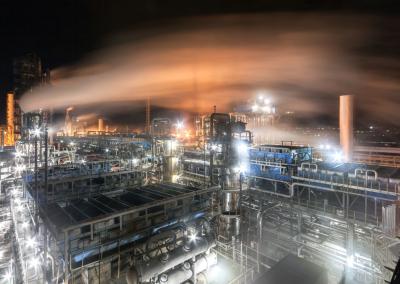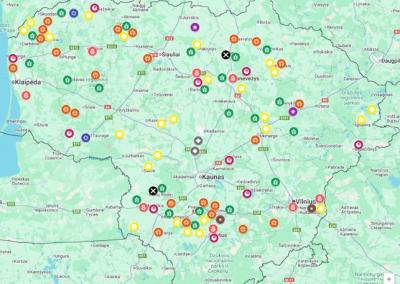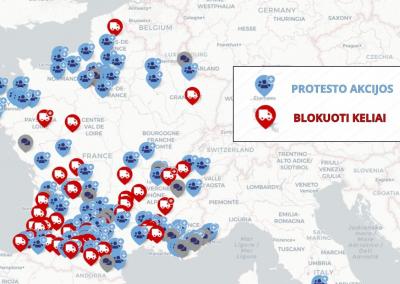European Commission publishes Communication on how to manage climate change risks in Europe
The European Commission (EC) has published a Communication on Climate Risk Management in Europe with concrete proposals in response to the European Environment Agency's European Climate Change Risk Assessment, to help the EU and its Member States manage climate risks.
The EC pointed out that maintaining and restoring the resilience of ecosystems will require storing around 30-50% of the Earth's climate resources. The EU will need to protect more than 30-30% of the Earth's terrestrial, freshwater and ocean ecosystems. Guidelines will be developed with Member States on how to build resilient landscapes to climate change, including the prevention of damage to ecosystems and the protection of marine ecosystems.
Climate change and the waves of war are increasing the risk of exacerbation of some diseases, and the Commission will strengthen Climate and Health Monitoring and assess further actions to protect people affected by high levels of war. Food security is also threatened by a changing climate and appropriate support measures will need to be developed to support the transition to resilient farming and fishing.
Urban infrastructure is threatened by floods, fires, cold temperatures and other extreme events, and the Commission will work to make design standards for buildings and infrastructure better adapted to the risks of climate change, and will encourage greater consideration of these risks in the planning of transport and energy infrastructure. Appropriate guidance will be developed to this end.
The EC will improve existing tools for climate change risk management and provide Member States with access to key aggregated and local data, applications and services.
In the event of emergencies, the „Galileo“ išearly warning satellite service will be available from 2025, allowing information to be transmitted even when ground-based warning systems are not operational. Data gaps are expected to be alleviated by the proposed Mi&scaron and Soil Monitoring Regulations, which will improve early warning tools for wildfires and other disasters, and help to assess potential risks more accurately.
Mobilizing sufficient public and private funds to build resilience to climate change is crucial. The EC plans to set up a temporary expert group on mobilising finance for climate resilience.According to the EC, 2023 was the hottest year since measurements began and the number of climate catastrophes was rising sharply. Global warming in 2023 increased by 1.48 ° C compared to pre-industrial levels, while ocean temperatures and Antarctic sea ice loss have dramatically exceeded all records.
Climate in Europe is changing at twice the rate of the rest of the world. Surface air temperatures on the old continent have had a recent 5-year average of 2.2°C higher than in pre-industrial times. Under an optimistic scenario, if global warming remains within the 1.5 °C limit of the Paris Agreement, Europe could see a 3 °C increase in average temperatures.
Conservative estimates suggest that the EU's gross domestic product (GDP) could fall by around 7% by 2100 as a result of increasing climate forcing.If global warming exceeds the 1.5°C limit set by the Paris Agreement, the total additional reduction in GDP for the EU as a whole could reach €2.4 trillion by 2031-2050. And in the future, annual coastal flood damages in Europe could reach €1.6 trillion by 2100, affecting 3.9 million people.
Lithuania's climate projections are not optimistic either. By the end of the year, the average annual air temperature in Lithuania will increase from 1.2℃ in the more optimistic scenario to 2.8℃ in the more pessimistic one. The highest temperatures are expected in December/January (3.9& 4.4℃) and the lowest in May/July (1.9& 2.1℃).The projected average increase in precipitation ranges from 42 mm or 6% in the more optimistic scenario to 98 mm or 14% in the more pessimistic scenario. Periods of heavy rainfall will increase, with the monthly rate išfalling over the course of a day. These days will be more frequent: from 14–16 to 18–20. There is therefore a chance that floods and flash floods will become more frequent in the future.This is not the first year that climate change adaptation in Lithuanian cities has been discussed, including the need for municipalities to prepare plans with concrete actions. Unfortunately, no municipality in Lithuania has yet done so on its own initiative, despite the fact that the Climate Change Mitigation and Adaptation Guidelines were developed as early as 2017.Our municipalities, although small, are very different, and therefore individual plans are needed.
Only Klaipėda City municipality, which is one of the most vulnerable to climate change, has a climate change adaptation plan. Several other municipalities are currently preparing such plans.
Minister for Environment š. In March, the Minister of Environment and Climate Change approved the Climate Change Adaptation Progress Facility, which will receive nearly €100 million in EU funding until 2029. Planned activities include reducing flood risks and damage, increasing the resilience of the Baltic Sea coast, developing a hydrological and meteorological observation network, raising public awareness and strengthening adaptation skills, and acquiring a multi-purpose vessel for managing climate change threats.













































































































